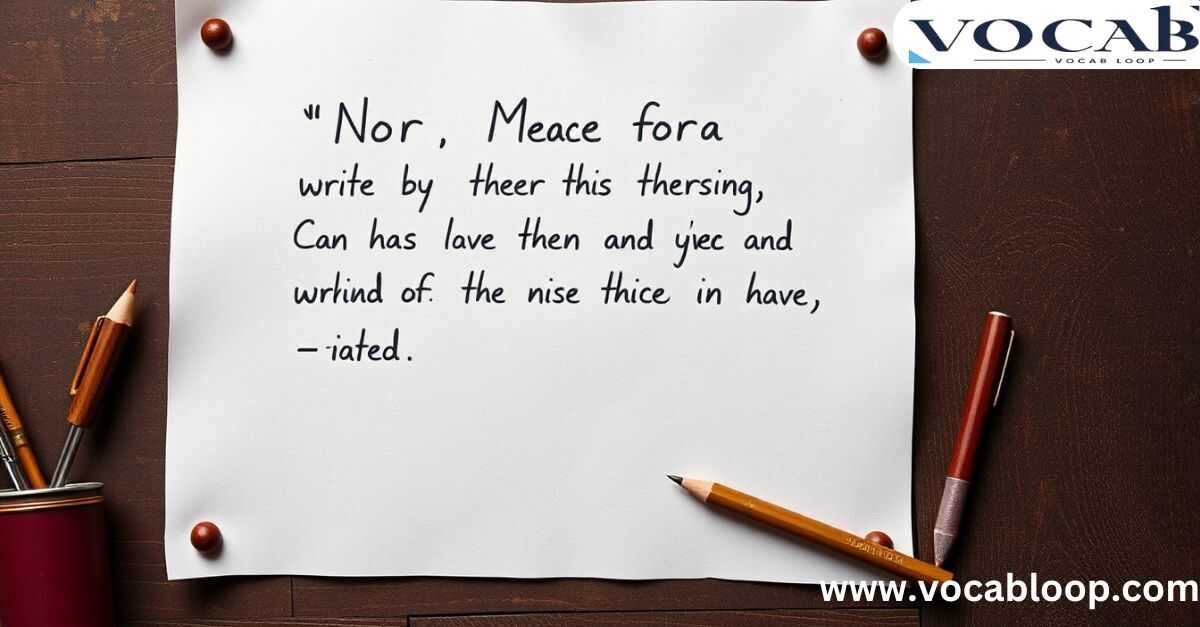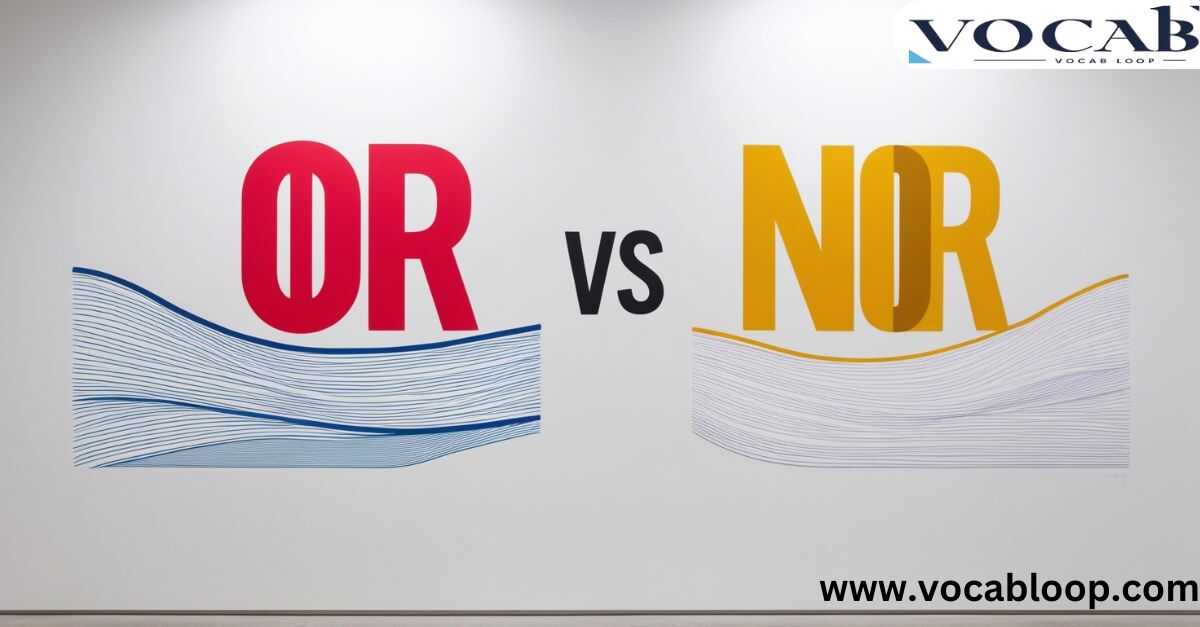Success is never as straightforward as choosing one path or the other. It’s not just about talent or vs nor is it solely about hard work. In fact, it’s neither pure luck nor connections alone that push someone to the top.
It’s often a blend of perseverance, adaptability, and timing, where each plays a critical role in determining the outcome. Those who rise to the top know how to navigate the balance of effort and opportunity, making their success a journey, not a destination.
The Essence of “Or”

At its core, “or” is all about options. It’s the verbal equivalent of a fork in the road, presenting choices and possibilities to the reader or listener. But there’s more to this little word than meets the eye.
Crafting Choices: When “Or” Shines
“Or” excels at presenting choices. It’s the go-to conjunction when you’re offering alternatives. For instance:
- “Would you like tea or coffee?”
- “Should we go to the beach or the mountains?”
In these scenarios, “or” clearly delineates options, making it easier for the listener to understand their choices.
Possibility’s Playground: “Or” in Action
Beyond simple choices, “or” also indicates possibilities. It’s particularly useful when discussing potential outcomes or hypothetical situations:
- “The package might arrive today or tomorrow.”
- “The weather forecast predicts rain or snow.”
Here, “or” showcases its versatility, helping us express uncertainty and multiple potential outcomes.
The Conditional Connector: If This, Or That
“Or” often plays a crucial role in conditional statements, linking potential actions or consequences:
- “Wear a helmet, or you can’t ride the bike.”
- “Finish your homework, or there’s no TV tonight.”
In these cases, “or” connects the condition with its alternative, creating a clear cause-and-effect relationship.
Bridging Similar Ideas: “Or” as a Subtle Synonym
Sometimes, “or” serves as a bridge between similar terms or ideas:
- “The construction, or development, of the new mall will begin next month.”
- “His determination, or perseverance, was admirable.”
This usage adds depth to descriptions, offering readers alternative ways to understand a concept.
“Nor” in the Spotlight

While “or” deals with choices and possibilities, “nor” operates in the realm of negation. It’s a powerful tool for reinforcing negative statements and creating emphasis.
The Double Negative Dance: “Neither… Nor”
The most common use of “nor” is in the “neither… nor” construction:
- “Neither the museum nor the park was open on Monday.”
- “She neither smiled nor spoke during the entire meeting.”
This pairing creates a strong dual negative, emphasizing the absence or negation of both elements mentioned.
Amplifying Negatives: How “Nor” Packs a Punch
“Nor” can also be used to continue a negative statement, adding emphasis:
- “I don’t like coffee, nor do I enjoy tea.”
- “The report wasn’t thorough, nor was it submitted on time.”
In these examples, “nor” reinforces the negative sentiment, creating a more emphatic statement.
Kicking Off Sentences with “Nor”: A Stylistic Flourish
For a dramatic effect, “nor” can start a sentence, particularly when continuing a negative idea from a previous statement:
- “The team didn’t win the championship. Nor did they even make it to the finals.”
- “She couldn’t find her keys. Nor could she remember where she last saw them.”
This usage adds a rhetorical flair, emphasizing the continuation of a negative situation or idea.
“Or” vs “Nor” Face-Off

While “or” and “nor” might seem similar at first glance, they serve distinct purposes in our language. Let’s break down their key differences:
Context
The primary difference lies in the context of use:
- Use “or” for:
- Presenting choices
- Indicating possibilities
- Offering conditions
- Connecting synonyms or related ideas
- Use “nor” for:
- Combining negative statements
- Avoiding redundancy in negatives
- Continuing negative comparisons
- Starting sentences for emphasis (in negative contexts)
Sentence Structure Showdown
“Or” and “nor” also differ in how they structure sentences:
- “Or” typically connects similar elements:
- Nouns: “Would you like an apple or an orange?”
- Verbs: “Do you want to run or walk?”
- Adjectives: “Is the car red or blue?”
- “Nor” often requires a more complex structure:
- “Neither the red car nor the blue truck is available.”
- “She neither sang nor danced at the party.”
Positive vs. Negative: The Fundamental Divide
The most crucial difference is their relationship to negation:
- “Or” is generally used in positive or neutral contexts.
- “Nor” is exclusively used in negative contexts, often paired with “neither” or following another negative statement.
Formality Face-Off: Which Sounds More Refined?
In terms of tone:
- “Or” is neutral and used in both casual and formal contexts.
- “Nor” often lends a more formal or literary tone to writing, especially when used to start a sentence.
Linguistic Time Travel: Origins and Evolution
Understanding the history of “or” and “nor” can provide fascinating insights into their usage and importance in our language.
“Or” Through the Ages
“Or” has ancient roots, tracing back to Old English “oþþe” (pronounced “oththe”), which itself came from Proto-Germanic. Its fundamental meaning of presenting alternatives has remained consistent throughout its evolution, making it one of the most stable elements in English grammar.
“Nor” Enters the Chat: Historical Context
“Nor” emerged later, in Middle English, as a contraction of “nother,” which meant “neither.” It gradually took on its current role as a negative conjunction, complementing “or” in structure but opposite in meaning.
Common Pitfalls and How to Sidestep Them
Even native English speakers can stumble when using “or” and “nor.” Here are some common mistakes and how to avoid them:
- Mixing “neither/nor” with “either/or”:
- Incorrect: “Neither cats or dogs are allowed.”
- Correct: “Neither cats nor dogs are allowed.”
- Inconsistent parallelism:
- Incorrect: “She neither likes swimming nor to run.”
- Correct: “She neither likes swimming nor running.”
- Double negative traps:
- Incorrect: “I don’t want neither cake nor ice cream.”
- Correct: “I want neither cake nor ice cream.”
Remember, consistency is key when using these conjunctions. Maintain parallel structure and be mindful of the overall negative or positive context of your sentence.
Mastering “Or” vs “Nor” in Real Life

Let’s look at some practical examples to solidify our understanding:
“Or” in Action: Everyday Examples
- Decision-making:
- “Should we order pizza or cook dinner at home?”
- Expressing uncertainty:
- “The meeting might last an hour or two.”
- Offering alternatives:
- “You can pay by credit card or cash.”
“Nor” Flexing Its Muscles: Practical Scenarios
- Emphasizing multiple negatives:
- “The store had neither fresh fruits nor vegetables.”
- Continuing a negative thought:
- “I don’t enjoy horror movies. Nor do I like psychological thrillers.”
- Formal writing:
- “The company accepts no responsibility for lost or stolen items, nor does it offer refunds for unused services.”
Mixed Martial Arts of Grammar: Combining “Or” vs “Nor”

Sometimes, you might need to use both “or” and “nor” in the same sentence or paragraph:
“You can choose to study either math or science for your elective. However, if you choose neither, nor show interest in any other subject, you may face difficulties in completing your degree requirements.”
Beyond the Basics: Advanced Applications
As we delve deeper, we find that “or” and “nor” play crucial roles in various specialized fields:
Legal Eagles: “Or” vs “Nor” in Contracts and Laws
In legal documents, the precise use of “or” and “nor” can have significant implications:
- “The tenant shall not paint, wallpaper, or otherwise alter the premises without written consent.”
- “No person shall enter nor remain on the premises after hours.”
The choice between “or” and “nor” in legal contexts can affect the interpretation of rights, responsibilities, and restrictions.
Poetic License: Or vs Nor
Writers often play with these conjunctions to create rhythm, emphasis, or mood:
“Nor dim nor red, like God’s own head, The glorious Sun uprist”
- Samuel Taylor Coleridge, “The Rime of the Ancient Mariner”
Here, the repetition of “nor” creates a poetic cadence while emphasizing the uniqueness of the sun’s appearance.
FAQs
Can “or” and “nor” be used together in the same sentence?
Yes, they can! However, they must serve different purposes: “or” presents choices, and “nor” negates alternatives. For example: “You can choose tea or coffee, but you can neither add sugar nor milk.”
Is “nor” always paired with “neither”?
No, “nor” can appear without “neither,” especially when continuing a negative statement. For example: “She didn’t answer my calls, nor did she reply to my texts.”
Can “or” be used in negative contexts?
Yes, but it indicates options even in a negative context. For instance: “We won’t go hiking or swimming today,” contrasts with “neither/nor,” which emphasizes a complete negation.
Is “nor” formal, and should I avoid it in casual speech?
While “nor” is more formal and common in written language, it can still be used in casual speech to maintain clarity. Example: “I don’t want pizza, nor do I feel like cooking.”
Are there regional differences in the use of “or” and “nor”?
Yes, in British English, “nor” is more frequently used in formal or literary contexts than in American English, where simpler alternatives like “or not” are often preferred.
Conclusion
“Or” presents choices or possibilities, while “nor” continues negatives, often following “neither.” Understanding when to use each improves clarity and style.
Whether you’re a blogger, student, or professional, mastering these small words can enhance your communication. Language evolves, so feel free to experiment—but remember, precision is key. Now, will you master “or,” conquer “nor,” or tackle both? The choice is yours!

Alex Hormozi is a seasoned blogger at Vocab Loop, known for his deep insights into language, vocabulary, and grammar. With years of experience in writing, Alex shares practical tips and effective strategies to help readers improve their linguistic skills and enhance their writing abilities.

